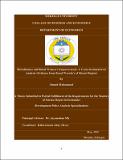| dc.description.abstract | Nowadays microfinance is proved to be the tool mechanism to handle poverty that resides mostly in rural areas of the country, and is also a basic mechanism to empower women’s economically, socially and politically. Thus majority of poor rural women’s in the Ethiopia don’t have access to financial services. Out of the total sample respondents taken for the study 40 % are matured clients, 24 % are incoming clients, 24 % are non-clients lives in the two of the woreda’s where the HMFI are giving group and individual loan, and 12 % are non-clients lives in the rural woreda where the institution does not giving loan. The result of the study reveals that, among the participants in the credit policy, 51 (41%) of them are empowered, matured clients was take the lion share by 37 (30%), and the remaining 16 (13%) incoming clients. From non-clients category, 14 (11 %%) of NCP and 5 (4%) of NCNP are also empowered in every dimension put to measure women’s empowerment. The result of the descriptive statistics shows that income and saving level of matured and incoming clients are better than the non-clients, matured and incoming clients have also better access and control over resources.
The result of econometrics analysis by using binary logistic regression model also shows that, variables like age of women’s respondents, age at marriage, marital status, education level of women’s, duration of women’s in the institution, income of their family, and non-formal education are the variables which can significantly affecting comulative women’s empowerment. Whereas, variables like religion of the respondents, form of marriage, access to media, head of family, and paid work variables are insignificant in affecting women’s empowerment. Accordingly propensity score matching was employed to see whether credit provided to women’s are empowered them or not. The result from all propensity score matching estimators shows participants are empowered due to their participation in the credit policy.
Hence, according to the study to empower women in dimension of economically, household level, personally and politically the institution is recommended to see the factors which lead poor rural women’s not to be empowered and providing a better lending strategy which is focusing on effective supervision, training and approval of appropriate loan size to empower women’s. | en_GB |


